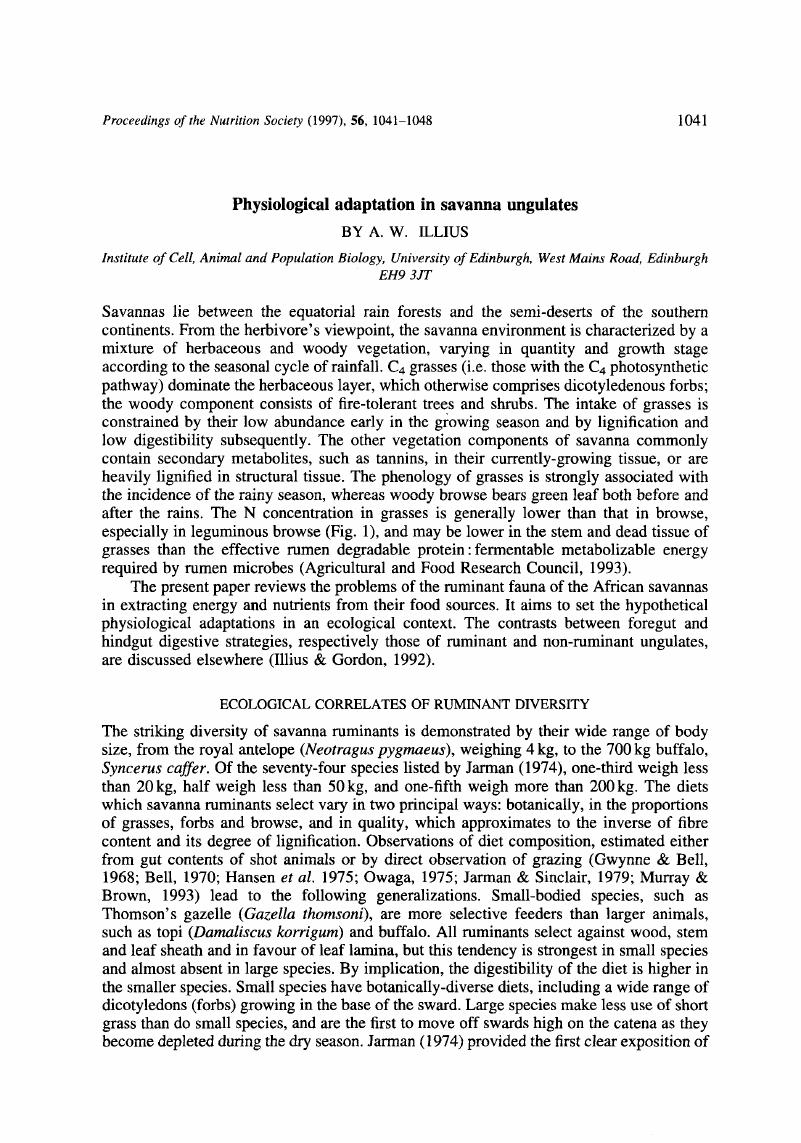Crossref Citations
This article has been cited by the following publications. This list is generated based on data provided by Crossref.
Ostrowski, Stéphane
Williams, Joseph B.
Bedin, Eric
and
Ismail, Khairi
2002.
WATER INFLUX AND FOOD CONSUMPTION OF FREE-LIVING ORYXES (ORYX LEUCORYX) IN THE ARABIAN DESERT IN SUMMER.
Journal of Mammalogy,
Vol. 83,
Issue. 3,
p.
665.
Clauss, Marcus
Lechner‐Doll, Matthias
and
Streich, W. Jürgen
2003.
Ruminant diversification as an adaptation to the physicomechanical characteristics of forage..
Oikos,
Vol. 102,
Issue. 2,
p.
253.
Sponheimer, Matt
Lee-Thorp, Julia A.
DeRuiter, Darryl J.
Smith, Jeannette M.
van der Merwe, Nikolaas J.
Reed, Kaye
Grant, C. C.
Ayliffe, Linda K.
Robinson, Todd F.
Heidelberger, Cory
and
Marcus, Warren
2003.
DIETS OF SOUTHERN AFRICAN BOVIDAE: STABLE ISOTOPE EVIDENCE.
Journal of Mammalogy,
Vol. 84,
Issue. 2,
p.
471.
BALDI, RICARDO
PELLIZA-SBRILLER, ALICIA
ELSTON, DAVID
ALBON, STEVE
and
Krausman
2004.
HIGH POTENTIAL FOR COMPETITION BETWEEN GUANACOS AND SHEEP IN PATAGONIA.
Journal of Wildlife Management,
Vol. 68,
Issue. 4,
p.
924.
Moen, Jon
Andersen, Reidar
and
Illius, Andrew
2006.
Large Herbivore Ecology, Ecosystem Dynamics and Conservation.
p.
50.
Capellini, I.
2006.
Evolution of body size in the genusDamaliscus: a comparison with hartebeestAlcelaphusspp..
Journal of Zoology,
Vol. 270,
Issue. 1,
p.
139.
Codron, Daryl
Lee-Thorp, Julia A.
Sponheimer, Matt
and
Codron, Jacqui
2007.
Nutritional content of savanna plant foods: implications for browser/grazer models of ungulate diversification.
European Journal of Wildlife Research,
Vol. 53,
Issue. 2,
p.
100.
Treydte, Anna C.
Heitkönig, Ignas M.A.
and
Ludwig, Fulco
2009.
Modelling ungulate dependence on higher quality forage under large trees in African savannahs.
Basic and Applied Ecology,
Vol. 10,
Issue. 2,
p.
161.
Scarano, Alejo C.
Carlini, Alfredo A.
and
Illius, Andrew W.
2011.
Interatheriidae (Typotheria; Notoungulata), body size and paleoecology characterization.
Mammalian Biology,
Vol. 76,
Issue. 2,
p.
109.
Cassini, G. H.
Vizcaíno, S. F.
Bargo, M. S.
and
Cassini, Guillermo
2012.
Body mass estimation in Early Miocene native South American ungulates: a predictive equation based on 3D landmarks.
Journal of Zoology,
Vol. 287,
Issue. 1,
p.
53.
Villagra, Edgar Sebastián
Pelliza, Alicia
Willems, Priscila
Siffredi, Guillermo
and
Bonvissuto, Griselda
2013.
What do domestic livestock eat in northern Patagonian rangelands?.
Animal Production Science,
Vol. 53,
Issue. 4,
p.
360.
Shamon, Hila
Boyce, Andy J.
Kunkle, Kyran
McShea, William J.
and
Campos Ferreira, Catarina
2022.
Unique utilisation pattern responses of five sympatric ungulates to local phenological gradients.
Wildlife Research,
Vol. 49,
Issue. 7,
p.
610.
Popp, Manuel R.
and
Kalwij, Jesse M.
2023.
Consumer-grade UAV imagery facilitates semantic segmentation of species-rich savanna tree layers.
Scientific Reports,
Vol. 13,
Issue. 1,



